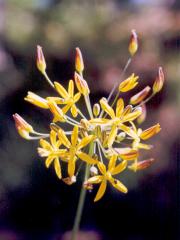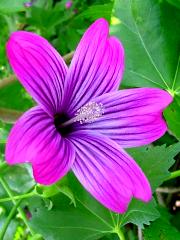About the site
This site currently contains photographs of 2,602 taxa of native and introduced Southern California plants. This represents about 60% of all the flora of Southern California, and new species are being added more or less continuously. I am now in the infinitely slow process of redoing the entire site to include where available whole plant photographs and other photographs of specific diagnostic features. About 300 pages are now in this new format. I am by no means satisfied with all of the photographs that are in the site now, but one of the great things about websites is that they are not static, and when you acquire a better picture it's easy to substitute it. So I will be looking to re-photograph many species in the coming years. Also, in some cases, I have included species for which I have only non-floral photos, and when I take pictures of the blooms I will add or substitute them.
As much as is possible, I have tried to be consistent with the latest published version of the Jepson Manual (Third printing with corrections, 1996). I know that many taxonomic changes are in the works (some Hemizonia to Deinandra for example), and I am now in the process of changing the names as they will appear in the 2nd edition of the Manual. The current scheduled publication date is 2010. I have also endeavored to introduce some consistency in the usage of common names, even where that does not exactly correspond to the names others have used. A good example would again be the Hemizonias, some of which have been called tarweeds and some tarplants. This attempt to be consistent has not always been successful, and indeed is probably not all that important.
The author names that have been added to all the pages can be referenced here.
I have also added photos of some of the cultivated plants that occasionally are found having escaped from gardens or having become naturalized near human habitations. Our temperate climate here in southern California allows many species from tropical and subtropical areas to thrive more or less year round, and people have taken advantage of that in planting their gardens and yards. If you are interested in garden flowers, I suggest you look at Dr. Barbara Collins' excellent website which is located at http://www.clunet.edu/gf/index.htm.
I should say a word about native vs. non-native plants. I am not a purist when it comes to introduced species. I happen to like weeds. Many of them have beautiful blooms. Therefore I am including flowering non-native species because sometimes those are the ones that are most frequently seen by people on their local rambles. So long as the plants are basically naturalized and living in a more or less wild environment, I do not draw distinctions between them and so-called "native" species. I will however indicate where such non-native species originally derive from.
A further note about weeds concerns the large number of plant species that somewhat incorrectly include the word 'weed' in their name. Of course, there is no definitive botanical meaning of 'weed' and they are usually described as being plants that are growing where they are not supposed to or anywhere you don't want them to, but the sense I have of them is that they are exotic, invasive and aggressive plants that tend to inhabit disturbed areas rather than wildlands. I have always been aware that there are plants called 'weeds' that are not in any real sense weeds, and that this can create a false impression, but until I went through my list of encountered plants with this in mind, I had no idea there were so many. The following are some of our native plants whose names include the word 'weed': tarweed, deerweed, telegraph weed, doveweed, arrowweed, locoweed or rattleweed, sneezeweed, bindweed, hawkweed, snakeweed or matchweed, burroweed, chinchweed, milkweed, coast weed, pickleweed, butterweed, horseweed, gumweed, cudweed, seepweed or inkweed, ragweed, smartweed, spikeweed, vinegarweed, rattlesnakeweed, cottonweed and stinkweed. I don't know how this trend developed, but I wish it hadn't and I sometimes try to fight it by substituting 'plant' for 'weed', but usually I just go along with the familiar name. It has been suggested to me that many plants named as 'weeds' were called that by farmers and ranchers for whom it was not where the plants evolved that was important but rather that they were intrusive and unwanted, and I think there may be validity in this assertion.
Speaking of plant names, I have often been struck by their almost poetic nature. Birds' names are certainly based more on descriptions and physical characteristics such as color, and perhaps only fish have some names that are seemingly just made up out of whole cloth, and I wonder what it is about plants that has evoked these kinds of naming traditions and conventions. To give you some idea of what I mean, I here list some common names that have intrigued me. Where these names came from is another subject that I may someday delve into, but not right now. Consider the following: baby blue eyes, beardtongue, bird's beak, bishop's cap, blackeyed susan, blazing star, bleeding hearts, blue dicks, blue-eyed mary, brass buttons, bride's bonnet, brown bells, bugseed, burning bush, butter-and-eggs, butterweed, chinese houses, cow parsnip, cream cups, dead man's fingers, dusty maidens, ear drops, fairy duster, fairy lantern, farewell-to-spring, foxglove, frost mat, frying pans, goldfields, gold nuggets, gravel ghost, hound's tongue, indian warrior, ithuriel's spear, jacob's ladder, johnny jump up, labrador tea, ladies thumb, lambs' quarters, languid ladies, lilac sunbonnets, liveforever, meadowfoam, milkmaids, miner's lettuce, monkshood, mountain misery, mulefat, mule's ears, old man's whiskers, our lord's candle, paintbrush, pennyroyal, pretty face, purple mat, pussy paws, ranger's buttons, rat's tails, red maids, scarlet pimpernel, shooting star, skullcap, sky pilot, smoke tree, snake's head, spanish needle, steer's head, sun cups, tidy tips, tinker's penny, turkish rugging, virgin's bower, whisker brush, whispering bells, windmills, winterfat, witch's hair, woody bottlewasher, woolen-breeches, and yellow-frocks. There's just something about plants that evokes names that are whimsical and out of the ordinary. For more detailed information about plant names, I refer you to my other website, California Plant Names: Latin Name Meanings and Derivations.
A further note about common names: A plant may be called by one name in one locality and by another elsewhere. There are no official common names that are recognized by everyone as there are for instance for birds. For this reason I have also listed the species in my site by their Latin names which are more generally and widely accepted. One organization which is attempting to standardize common names for many California plants is Calflora.org, whose excellent and informative website is to be found at: www.calflora.org/species/index.html. While I don't always agree with the names they have chosen to use, I heartily applaud their efforts, and I have frequently deferred to their common names.
The habitat, blooming period and other botanical information included here was extracted mainly from the Jepson Manual and from Philip Munz, A Flora of Southern California, and A California Flora and Supplement, with some additional information from my favorite field book Wildflowers of the Santa Monica Mountains by Milt McAuley, and from the excellent books of Dr. Barbara Collins, Beecher Crampton's Grasses in California, Nancy Dale's Flowering Plants of the Santa Monica Mountains, Roxana Ferris's book on Death Valley flora, Jon Mark Stewart's two books on the wildflowers of the Mojave and Colorado Deserts, and Milt Stark's book on Antelope Valley flora. As far as possible, the scientific names used in this site are in accord with those in the latest published edition of the Jepson Manual. When the 2nd edition is published there will be many name changes, and in the meantime anyone interested in the new names may go this website: Index to Names Superseded since the Jepson Manual.
One final caveat: I am not a professional botanist and do not guarantee the correct identification of these photographs. Where I have been able to key out species, I have done so to the best of my meager ability, but I have not always had the opportunity to do that. I have in most cases relied on those identifications made by professional botanists in the field, but even they may sometimes be in error. If anyone has any doubts about a particular identification, please feel free to contact me at: mmlcharters@calflora.net.


